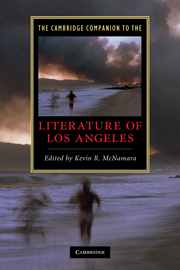Book contents
- Frontmatter
- Introduction: landmarks
- 1 The literature of the Californios
- 2 The Anglo invention of Los Angeles
- 3 LA fiction through mid-century
- 4 British expatriates and German exiles in 1930s-1940s Los Angeles
- 5 Postwar Los Angeles: suburban Eden and the fall into history
- 6 Los Angeles and the African-American literary imagination
- 7 Pacific Rim city: Asian-American and Latino literature
- 8 The literature of urban rebellion
- 9 City of sleuths
- 10 Los Angeles’ science fiction futures
- 11 Hollywood fictions
- 12 The Southland on screen
- 13 Scenes and movements in Southern California poetry
- 14 Surf, sagebrush, and cement rivers: Reimagining nature in Los Angeles
- 15 Essaying Los Angeles
- Guide to further reading
- Index
1 - The literature of the Californios
Published online by Cambridge University Press: 28 May 2010
- Frontmatter
- Introduction: landmarks
- 1 The literature of the Californios
- 2 The Anglo invention of Los Angeles
- 3 LA fiction through mid-century
- 4 British expatriates and German exiles in 1930s-1940s Los Angeles
- 5 Postwar Los Angeles: suburban Eden and the fall into history
- 6 Los Angeles and the African-American literary imagination
- 7 Pacific Rim city: Asian-American and Latino literature
- 8 The literature of urban rebellion
- 9 City of sleuths
- 10 Los Angeles’ science fiction futures
- 11 Hollywood fictions
- 12 The Southland on screen
- 13 Scenes and movements in Southern California poetry
- 14 Surf, sagebrush, and cement rivers: Reimagining nature in Los Angeles
- 15 Essaying Los Angeles
- Guide to further reading
- Index
Summary
The Pueblo of la Reina de Los Angeles was founded on what the Spanish named the Porciúncula, or Los Angeles River, by eleven families in September 1781, ten years after the establishment of the San Gabriel Mission. A village composed of about forty-four individuals, mostly mulatto, mestizo, and Indian settlers from northwestern Mexico (Sonora and Sinaloa), Los Angeles was established in an area inhabited by several hundred Shoshana Indians, who after Spanish colonization were known as the Gabrielinos and Fernandinos, according to whether they served at the San Gabriel or San Fernando Mission. The total population of the pueblo varied according to the comings and goings of presidio soldiers and their families, some of whom had come with the earlier colonists in 1769. By 1790 there were 140 Spanish-speaking settlers, the Californios, or gente de razón (rational people), as they called themselves, who, with this term, distinguished themselves from the local Indians. The growth of the pueblo of Los Angeles, like that of Alta California, was limited during the second period of settlement under Mexican rule (1822-46); it attracted a few colonists from Mexico, and some foreigners, especially traders, sailors, and trappers. The US invasion of Alta California in 1846 brought hundreds of soldiers to the area, some of whom remained after the war's end.
- Type
- Chapter
- Information
- The Cambridge Companion to the Literature of Los Angeles , pp. 13 - 22Publisher: Cambridge University PressPrint publication year: 2010

